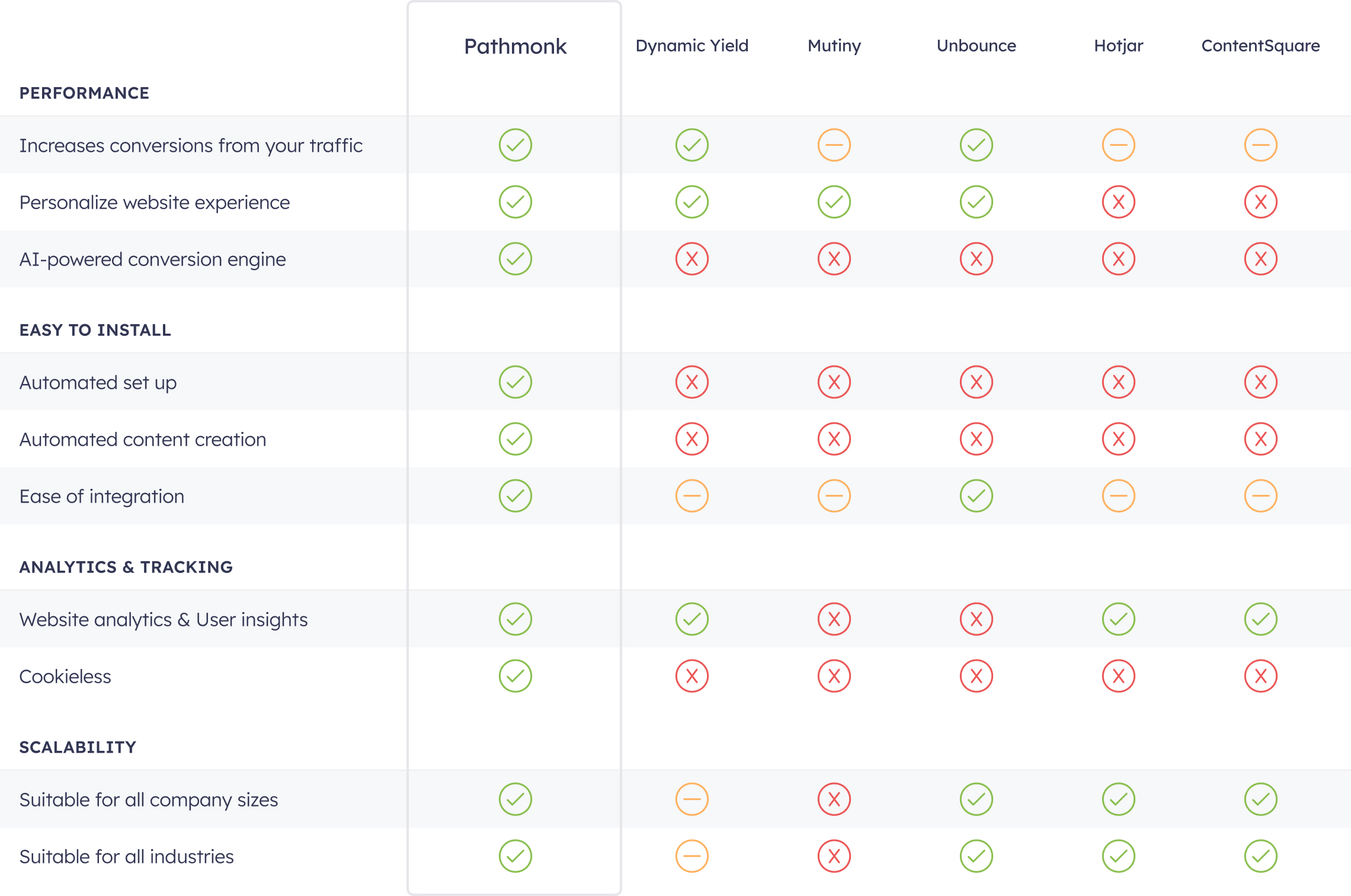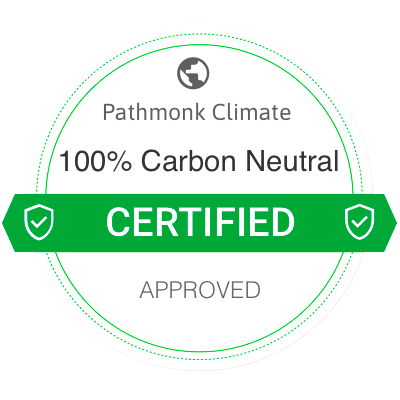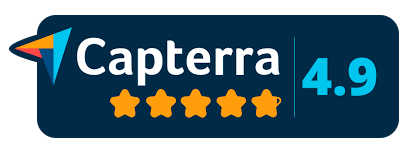Pathmonk for Healthcare
Grow your healthcare business with trust-building interactions
Convert more website visitors into loyal customers and patients. Guide every journey—from research to purchase—with real-time personalization that scales.
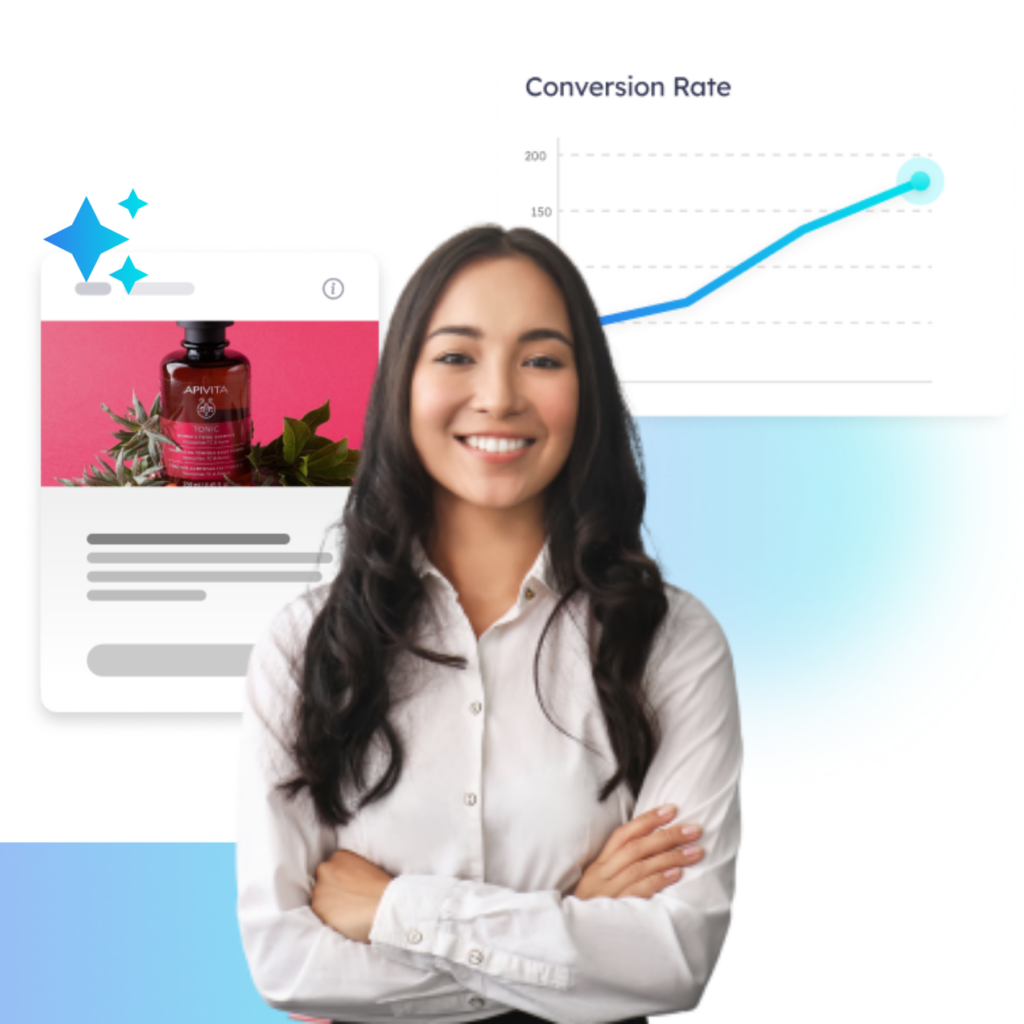
Automated personalization
Cookieless technology
Real-time analytics
No website changes needed
How healthcare brands boost conversions with customer journey personalization
Healthcare has drastically changed in the last few years. From diabetes supplies to advanced therapeutic treatments, more and more people start their search for care online. That means healthcare companies have invested heavily in digital marketing to reach them, but driving traffic is only half the story.
If your website isn’t converting visitors into real patient inquiries, appointment requests, or new accounts, your competitors will win the game. Conversion optimization for healthcare websites isn’t just about growth, it’s about making it easier for patients to get the help they need while ensuring your business stays competitive.
In this guide, we’ll break down:
- The main marketing challenges healthcare companies face today
- Benchmarks and data to see how your results stack up
- Why improving conversions is often the fastest way to grow
- How Pathmonk can help you engage patients more effectively without big tech overhauls
- Real examples from companies already seeing success
Let’s take a closer look at what’s holding most healthcare websites back, and how you can turn more visits into outcomes that matter.
Market overview & trends in the healthcare industry
Healthcare has been evolving fast, with more patients turning to digital channels to learn about treatments, book appointments, and manage chronic conditions. From semaglutide demand to AI integration, here’s what’s shaping the landscape right now.The boom in semaglutide and weight-loss treatments
One of the biggest shifts in healthcare marketing is the explosive growth of semaglutide-based medications, such as Ozempic and Wegovy, used for diabetes and weight management.The global semaglutide market is projected to grow from $27.15 billion in 2024 to $61.7 billion by 2033, with a CAGR of 9.55%. At the same time, the overall weight-loss drug market could reach $150 billion globally by 2035.
This surge is creating intense competition among providers and suppliers to capture patient interest and build trust early in the decision-making journey.
⭐ See how Allure Medical turned more website visitors researching semaglutide treatments into booked appointments.
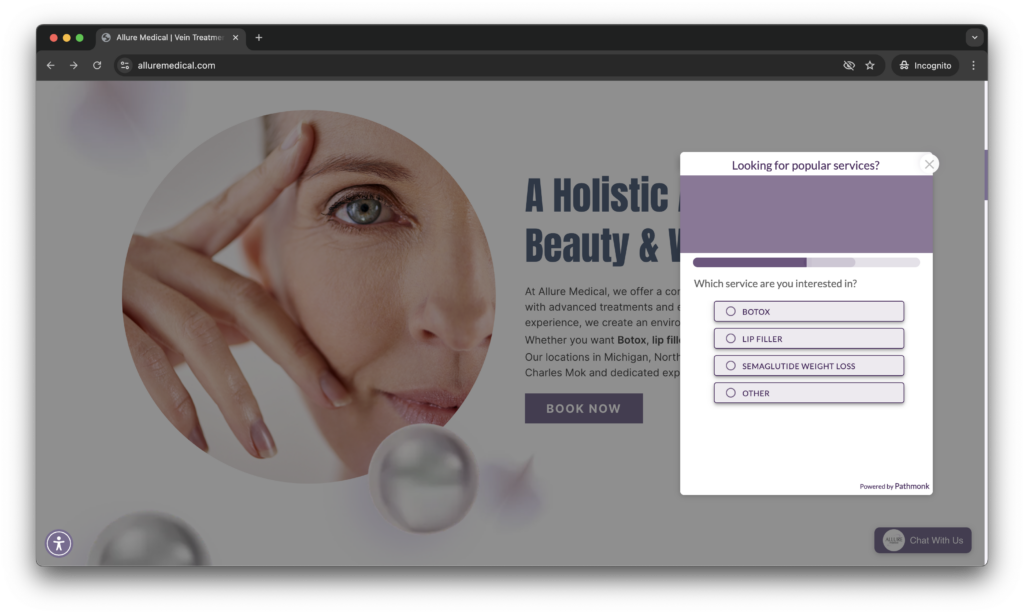
Digital health adoption and AI integration
More healthcare providers are integrating digital solutions and artificial intelligence to improve care delivery and marketing performance. Recent surveys show 85% of healthcare leaders are exploring or actively using generative AI, whether for automating administrative tasks, enhancing patient communication, or supporting clinical decision-making.These tools help healthcare brands personalize experiences at scale and optimize conversions across touchpoints.
⭐ See how Tivic Health used AI-powered personalization to drive more purchases of their ClearUP device.
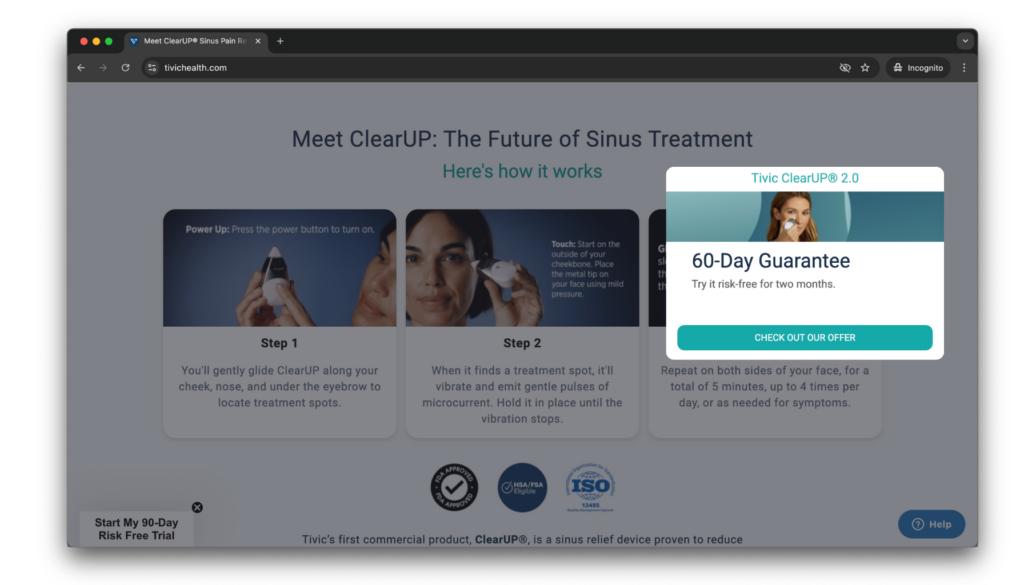
Wearables and patient empowerment
Wearable health devices are becoming mainstream, enabling patients to track vitals like heart rate, blood sugar, and activity levels in real time. Governments and insurers are backing this trend, launching campaigns to encourage adoption and improve preventive care.For healthcare marketers, this means more opportunities to engage patients through integrated digital experiences that align with self-monitoring and proactive health management.
⭐ See how MediVera guided different audiences to the right resources and boosted qualified leads.
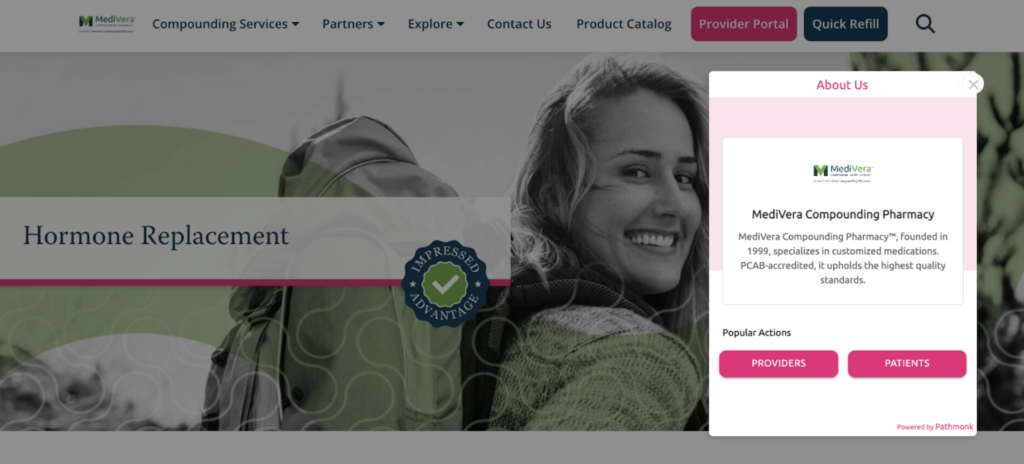
Implications for healthcare marketing strategies
The common thread across these trends is clear: patients expect seamless, personalized digital experiences.
To keep up, healthcare companies need to:
- Leverage data-driven insights to understand patient intent
- Use AI to tailor messaging and calls to action
- Build credibility and trust from the first visit onward
Keeping pace with these shifts is the key to staying relevant and driving sustainable growth.
What are the main challenges faced by marketing in healthcare?
Healthcare marketing comes with a unique set of hurdles most industries never have to think about.
Whether you’re helping people manage chronic conditions like diabetes or exploring new treatments for weight loss, you’re navigating sensitive decisions, strict regulations, and a lot of skepticism.
Here are some of the biggest challenges standing in the way of better conversions and sustained growth:
1. Complex and sensitive buying journeys
Healthcare decisions aren’t simple. People rarely click “buy now” on an insulin delivery system or sign up for a therapeutic treatment after one visit to your website. Instead, they spend days—or sometimes months—reading about their options, comparing costs, and talking things through with family or doctors. There’s a lot at stake, and that makes the path to conversion slow and unpredictable.
If your marketing assumes that everyone is ready to take action right away, you’ll end up losing people who just need more reassurance, clearer information, or more time. Guiding them through this journey means showing up consistently, offering resources that match each stage of consideration, and making it feel safe to take the next step when they’re ready.
2. Strict regulations and privacy requirements
The healthcare sector is under constant scrutiny, and for good reason. You’re handling sensitive health information and making claims about outcomes that can impact someone’s wellbeing. But this also means you have to work within tight boundaries that limit what you can say and how you can track engagement.
Standard tactics like retargeting ads or collecting detailed behavioral data often aren’t allowed, or at the very least require extra layers of consent and compliance reviews. Many marketing teams feel like they’re operating half-blind, unable to see which channels are performing or who’s actually ready to convert. All of this can slow campaigns down and make it harder to prove what’s working.
3. Low trust and high skepticism
People are naturally skeptical about healthcare marketing, especially online. They’ve seen too many ads making big promises or glossing over the fine print. That skepticism doesn’t just affect sketchy products, it spills over onto legitimate providers and suppliers too.
Winning trust takes more than professional branding. Patients want evidence that you’re credible, transparent, and genuinely looking out for their interests. If your website feels confusing or makes it hard to get straight answers about costs, qualifications, or expected results, you’re likely to lose them to someone who communicates more clearly.
Building that trust is an ongoing process. It’s about clear language, consistent messaging, and removing any friction that makes people wonder if you’re the right choice.
These challenges are real, and they’re not going away. But understanding them is the first step to creating a marketing strategy that respects your audience, meets regulatory demands, and still moves the needle on conversions.
Healthcare industry benchmarks
Healthcare marketing is often more expensive and slower-moving than other industries.
Even when you’re targeting an audience that needs care, converting website visits into actual patients takes time and careful nurturing. If you’re wondering how your performance compares to others in the field, here are some credible benchmarks to consider:
Healthcare industry conversion rate
Most healthcare websites convert between 1% and 2% of visitors into a lead—meaning someone who fills out a form or requests more information. Actual appointment bookings or paid conversions are lower, typically 0.5–1% of total traffic. Even high-performing sites rarely exceed 3–4%, given the complexity of decisions and the trust patients need to feel before committing.
Healthcare industry Cost per Lead (CPL)
Depending on the service and market, the cost per lead usually falls in the range of $75–$250. Highly specialized services—such as bariatric surgery, semaglutide programs, or diabetes equipment—often sit at the higher end or exceed it, especially when relying on Google Ads and other paid channels.
Healthcare industry Customer Acquisition Cost (CAC)
Acquiring a single paying patient is typically $350–$600 on average, though this can reach $800–$1,000+ in competitive areas or for high-ticket treatments. CAC includes all marketing expenses plus any time and operational costs related to nurturing and onboarding new patients.
Time to close the deal in the healthcare industry
The timeline from first website visit to an actual booking or sale varies widely. For more routine services, it may take 7–14 days. For specialized treatments, elective procedures, or chronic condition management, it’s common for the cycle to stretch to 30–90 days or longer, especially when insurance verification and clinical consultations are required.
| Metric | Healthcare – typical range |
| Conversion rate | 0.5–2% |
| Cost Per Lead (CPL) | $75–$250+ |
| Customer Acquisition Cost (CAC) | $350–$600+ (often higher in niche) |
| Time to close | 7–90 days, depending on complexity |
These benchmarks reflect the reality for most healthcare companies today. They highlight why simply increasing website traffic isn’t enough—improving conversion rates and reducing friction across the journey are essential to control costs and grow sustainably.
Why conversion optimization is critical in the healthcare industry
It’s easy to focus all your energy (and budget) on getting more people to visit your website. That’s what most healthcare organizations do: buy ads, run listings, invest in SEO. But in reality, if your site isn’t set up to convert, you’re simply paying to have people leave.
The thing about healthcare, as we just mentioned above, is that decisions are rarely quick. People are careful. They want to be sure they can trust you, that you understand their needs, and that you’re transparent about what to expect. If any of that feels unclear or overwhelming, they’ll move on. That’s why conversion optimization matters so much: it’s about removing the friction that keeps good-fit patients from taking the next step.
Here’s a simple way to look at it: if your website gets 10,000 visits a month and converts 1% of them into leads, that’s 100 inquiries. Bumping that up to 2% doesn’t sound dramatic on paper, but it means 100 more people reaching out, without any extra advertising. Over time, that difference can easily translate into hundreds of thousands of dollars in new revenue, especially if you offer specialized care or high-value treatments.
Beyond the numbers, better conversion means you’re meeting people where they are. You’re helping them feel comfortable, answering their questions up front, and showing them exactly how to move forward. In an industry where trust is everything, that kind of clarity makes a difference.
The truth is, most healthcare websites are still set up like digital brochures. They have plenty of information but don’t do much to guide someone through a complex, emotional decision. Optimizing the experience so it feels simple, supportive, and credible, often does more for growth than doubling your ad spend.
How Pathmonk increases conversions for companies in the healthcare industry
Healthcare websites have to do more than look professional: they need to guide people through decisions that feel personal, sometimes overwhelming, and often time-sensitive. That’s why a one-size-fits-all approach usually falls short.
Pathmonk is designed to adapt in real time to what each visitor cares about, without relying on invasive tracking or complex manual workflows. Instead of treating every click the same, it helps you create a smoother, more relevant experience that builds trust and encourages action.
This is how Pathmonk works:
1. Intent analysis and detection
Pathmonk doesn’t just look at which pages someone visits, it pays attention to how they explore your site. It tracks patterns like how long a person stays, whether they come back multiple times, and the sequence of content they view. This helps you understand the difference between someone casually browsing and someone who’s close to taking action. For example, a visitor who checks your diabetes treatment page once is likely in the early research stage. But if that same person returns a few days later to compare semaglutide options, reads insurance FAQs, and looks at testimonials, they’re probably much more serious.2. Behavior prediction
Once Pathmonk has a sense of a visitor’s intent, it goes a step further by predicting what they’re most likely to do next. This isn’t based on simple rules or assumptions: it draws on patterns learned from billions of data points across industries and user journeys. For example, if someone has visited your semaglutide treatment page several times and spent time on pricing information, Pathmonk can predict with a high degree of confidence that their next step might be looking for a way to schedule a consultation or check insurance coverage. These predictions happen in real time, while the visitor is still on your site. That means you don’t have to wait for them to bounce or hope they come back later. Instead, you can automatically surface the right prompt, guide, or call to action in the moment when they’re most likely to engage.3. Experience personalization
Based on the visitor’s intent and predicted next step, Pathmonk automatically delivers small, targeted interactions—what we call microexperiences—that fit their stage in the decision process. If someone is in the awareness stage, still gathering basic information, Pathmonk might show an educational video. For visitors in the consideration stage, it can surface a side panel comparing treatment options, customer testimonials, or answering common insurance questions. And when someone reaches the decision stage, ready to act, Pathmonk makes it easy to book a consultation, request a quote, or get matched with the right specialist. The key is that these microexperiences appear naturally, without disrupting the visit or feeling like pushy pop-ups. Instead, they feel like helpful nudges, timely and relevant, so patients have the confidence to move forward at their own pace.4. Detailed customer journey analytics
Beyond personalizing the experience, Pathmonk gives you a clear window into what’s actually happening on your website. With detailed customer journey analytics, you can see how visitors move from first touch to conversion—and where they drop off along the way. Instead of just showing basic metrics like pageviews or bounce rates, Pathmonk maps each step of the journey:- Which pages and resources get the most engagement
- How long it takes visitors to progress from awareness to decision
- How is the customer journey of each channel, source, or campaign
Allure Medical: +54% more booked appointments in just 30 days with Pathmonk
- Company type: Service
- Sector: Healthcare & wellness clinics
- Conversion goal: Book more appointments online
- Challenge: Converting expensive traffic from paid campaigns
- Key treatments: Hormone therapy, semaglutide weight-loss programs, regenerative medicine
- Behavior-based qualification flows that asked visitors what treatment they were interested in—like Botox, lip filler, or semaglutide—and adapted the experience accordingly.
- Microexperiences for each decision stage: welcoming videos and key selling points for people in the awareness phase, patient testimonials for those comparing options, and clear CTAs like “Book Now” for ready-to-act visitors.
- Interactive FAQs embedded on service pages so patients could get answers without having to dig through the site or call the clinic.
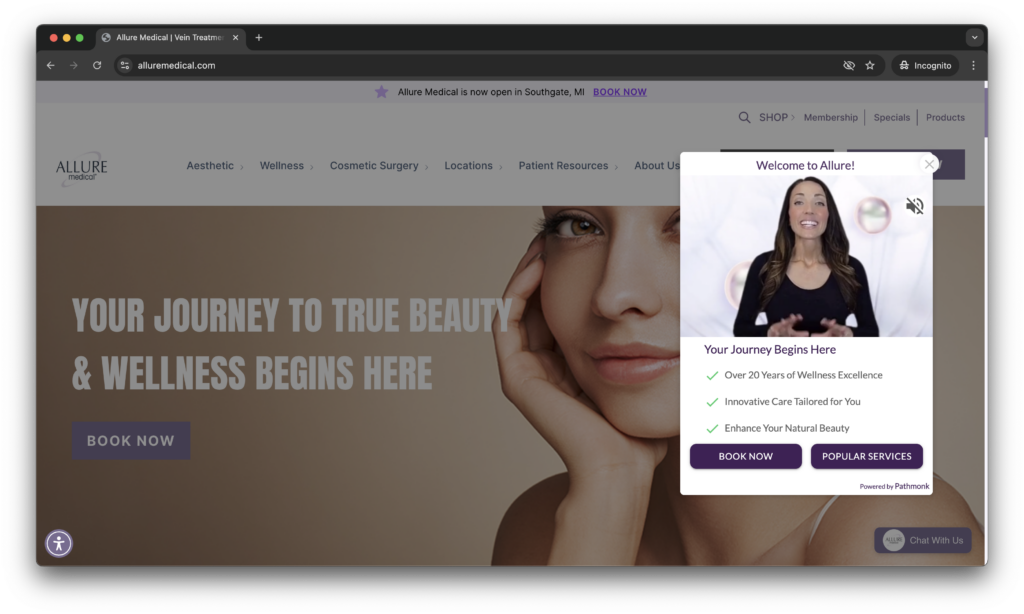
Everything ran automatically, adapting to each visitor’s intent in real time.
The results: In just the first month, Allure Medical saw a +54% increase in booked appointments, growing conversion rates from 3.83% to 5.91%. These gains came purely from improving the on-site experience—no extra ad spend or changes to traffic volume.
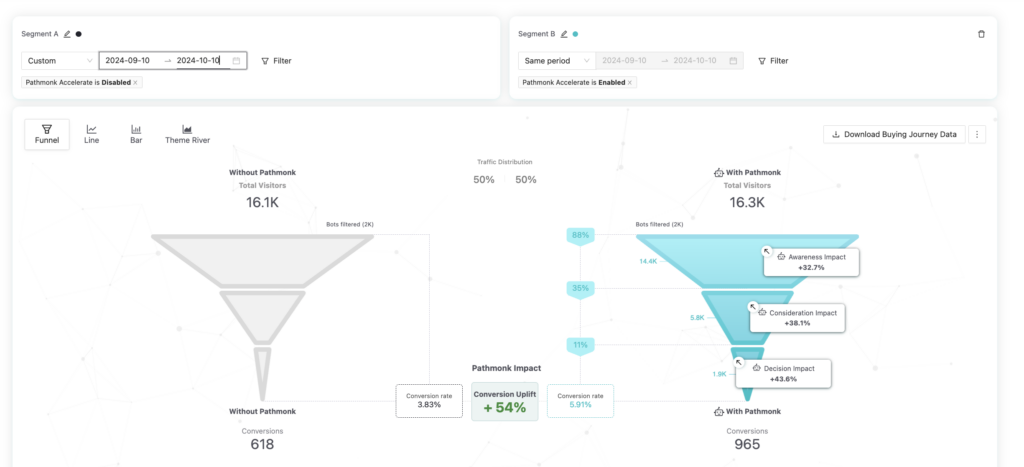
- Conversion rates on Pathmonk-optimized traffic eventually reached 9.01%, compared to 6.61% in the control group.
- Engagement lifted across every funnel stage, with the biggest gains at the decision point when patients were closest to booking.
MediVera: +40% more qualified leads with Pathmonk
- Company type: Service
- Sector: Compounding pharmacy
- Conversion goal: Capture more qualified leads through online forms
- Challenge: Guiding different audiences (patients and healthcare providers) to the right resources
- Key services: Custom hormone therapies, personalized medications, provider compounding support
- Qualification flows that asked visitors whether they were patients or healthcare providers and immediately directed them to the most relevant content.
- Custom side menus that made navigation clear and simple for both audiences, reducing friction.
- Dynamic content updates so the team could adjust messaging quickly without redesigning pages or relying on manual edits.
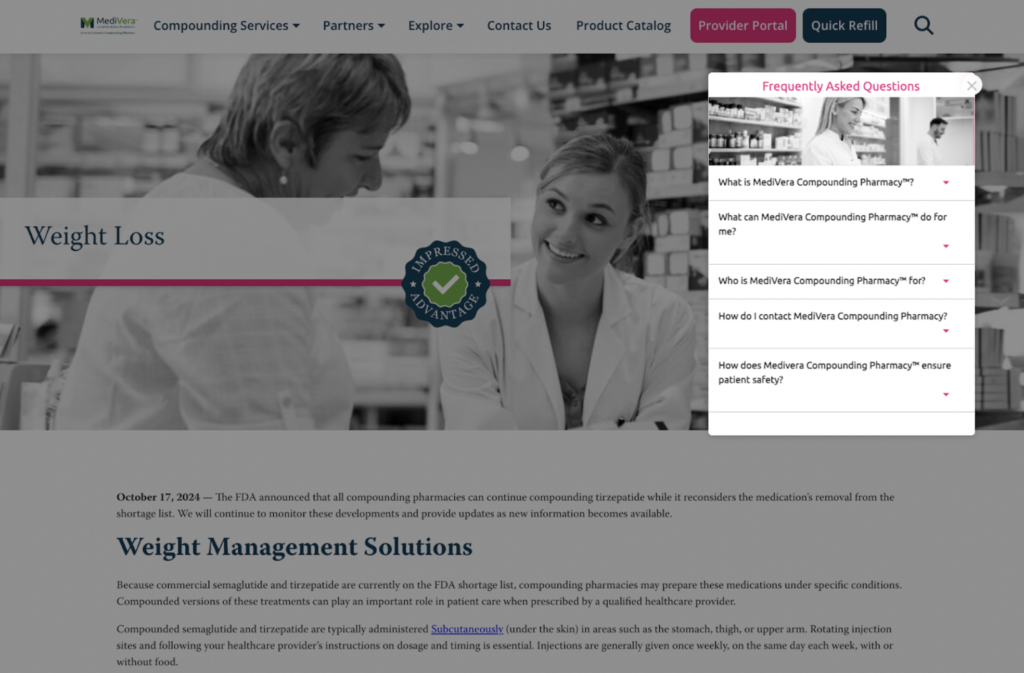
Everything worked automatically, adapting in real time to each visitor’s needs.
The results: In just the first month, MediVera saw a +40% increase in qualified leads, driven by clearer navigation and better guidance:
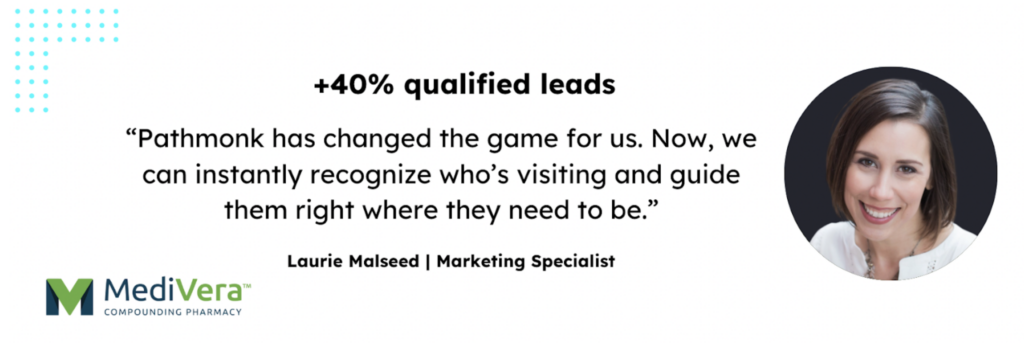
- 40% more form submissions overall, as more providers completed key forms.
- Visitors engaging with Pathmonk’s experiences were twice as likely to complete priority actions.
- Simple “quick fill” forms generated 209 completions, showing how much impact removing friction can have.
Be Fit South Shore: +54% more VIP trials booked with Pathmonk
- Company type: Service
- Sector: Health & fitness
- Conversion goal: Increase sign-ups for trial memberships
- Challenge: Complex user journey with high competition
- Key services: Personalized training, group classes, specialized bootcamps
Be Fit South Shore is a dynamic fitness business offering personalized training, group classes, and specialized bootcamps to help people achieve their health goals. But like many fitness companies, they struggled to turn website traffic into actual bookings.
The main issues were a complex user journey, a generic experience that didn’t feel relevant to each visitor, and persistently low conversion rates despite different acquisition strategies. Visitors often got stuck or lost interest before taking action.
How Pathmonk helped: Be Fit South Shore used Pathmonk’s AI-powered personalization to simplify the buying journey and make it easier for people to sign up. The approach included:
- Introduction videos at the awareness stage, featuring team members explaining the value of the programs and creating a quick, personal connection.
- Reviews and case studies showcased during the consideration phase to build trust with authentic social proof.
- One-click signup with an integrated calendar booking page, allowing visitors to claim their trial from anywhere on the site without friction.
Everything was automated and adapted in real time to each visitor’s behavior and stage.
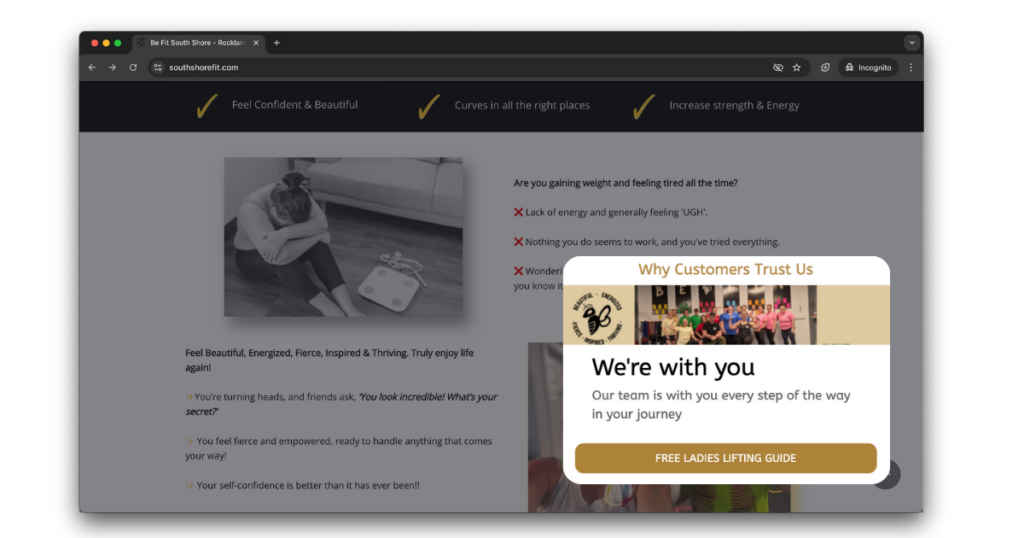
The results: After implementing Pathmonk, Be Fit South Shore saw a +54% increase in website conversions, leading to more VIP trial bookings and membership sign-ups:
- Sign-ups for trials rose sharply, directly boosting new customer acquisition.
- Engagement improved across the site as visitors interacted with videos, testimonials, and easy signup options.
- The team gained clear reporting and A/B testing data, helping refine their strategy based on real insights.
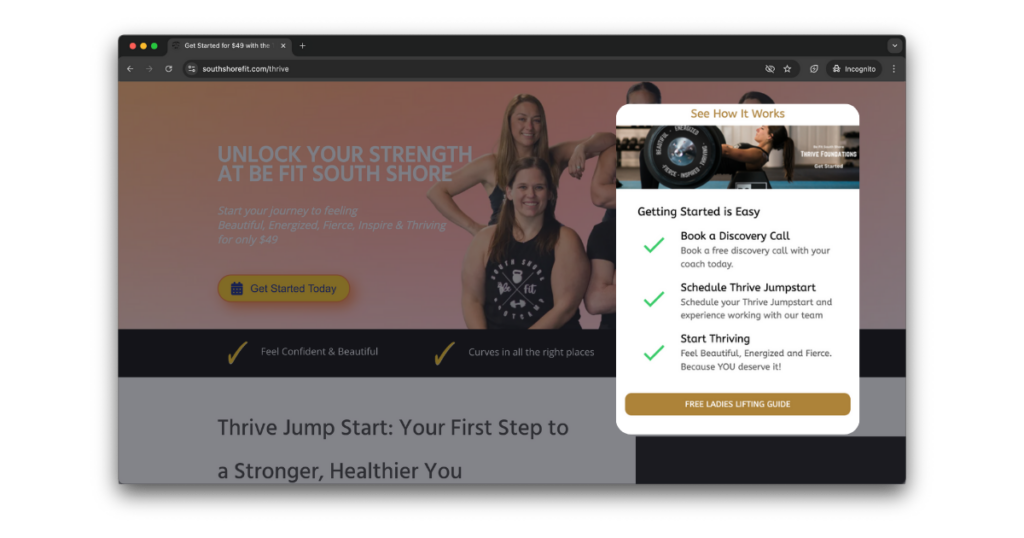
Iron Neck: +26% more e-commerce sales with Pathmonk
- Company type: E-commerce
- Sector: Sports & injury prevention equipment
- Conversion goal: More website sales
- Challenge: High-ticket product with a long shopping journey
- Key product: Neck-strengthening devices
Iron Neck was founded by former UCLA football player Mike Jolly to help reduce concussions through innovative neck-strengthening equipment. While the brand attracted plenty of interest online, many visitors needed reassurance and guidance before committing to purchase.
The main challenge was making the buying journey clear and confidence-building—from explaining why neck strength matters to helping customers pick the right product.
How Pathmonk helped: Iron Neck partnered with Pathmonk to create a more helpful, engaging, and personalized shopping experience. The approach included:
- Introduction videos at the awareness stage to quickly explain the benefits of neck training and showcase how the products work.
- Customer reviews and testimonials highlighted during the consideration phase to build trust and show real-world results.
- A short product selection quiz that asked visitors a few simple questions about their goals and recommended the best-fit Iron Neck model, reducing decision fatigue and making the process feel personalized.
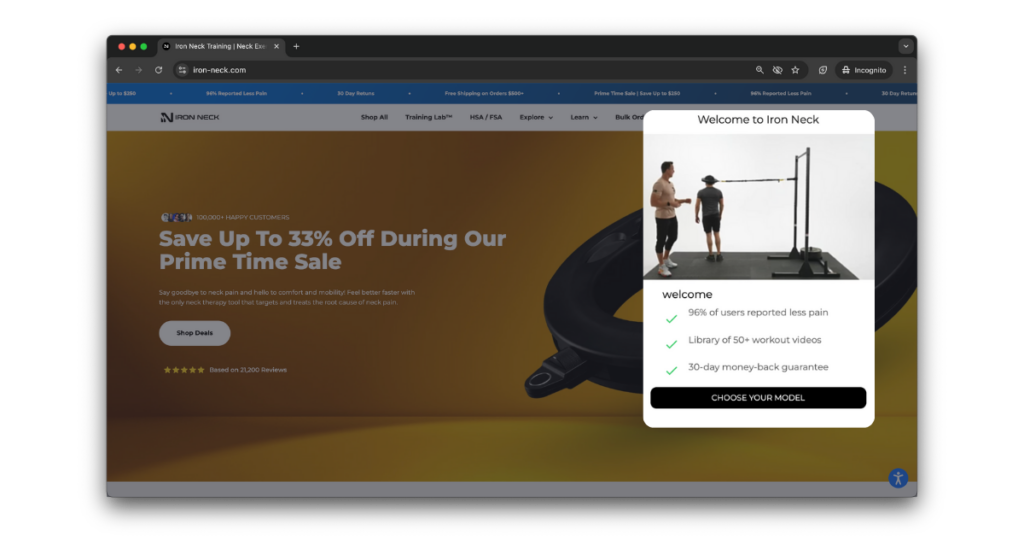
All of this ran automatically and adapted to each visitor in real time.
The results: In less than four weeks, Iron Neck saw a +26% increase in website purchases:
- More shoppers completed their orders after engaging with videos, reviews, and the product quiz.
- Customers reported feeling clearer about which product to choose, improving satisfaction and reducing hesitation.
- The website became easier to navigate and more effective at turning interest into sales.
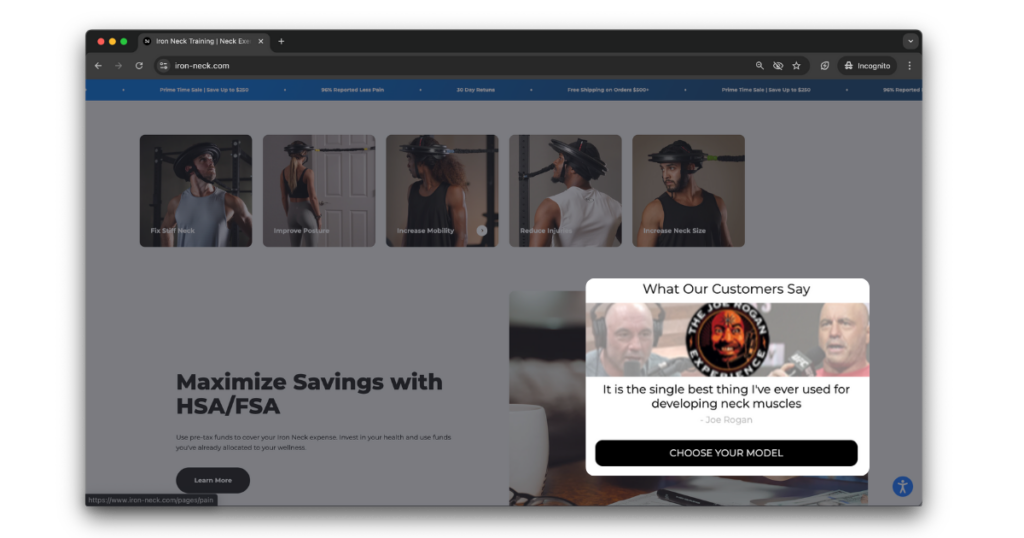
Tivic Health: +65% more purchases with Pathmonk
- Company type: E-commerce
- Sector: Health technology
- Conversion goal: Increase direct sales of high-ticket medical devices
- Challenge: Educating visitors and guiding them through a complex buying journey
- Key products: ClearUP Sinus Relief bioelectronic device
- Behavior analysis to track where visitors were spending time, what content they engaged with, and where they hesitated or dropped off.
- Personalized interactions like product recommendations, reviews, and answers to common questions, all tailored to each visitor’s intent and stage in the buying journey.
- A/B testing to measure exactly how AI-driven content influenced engagement and conversion compared to the control group.
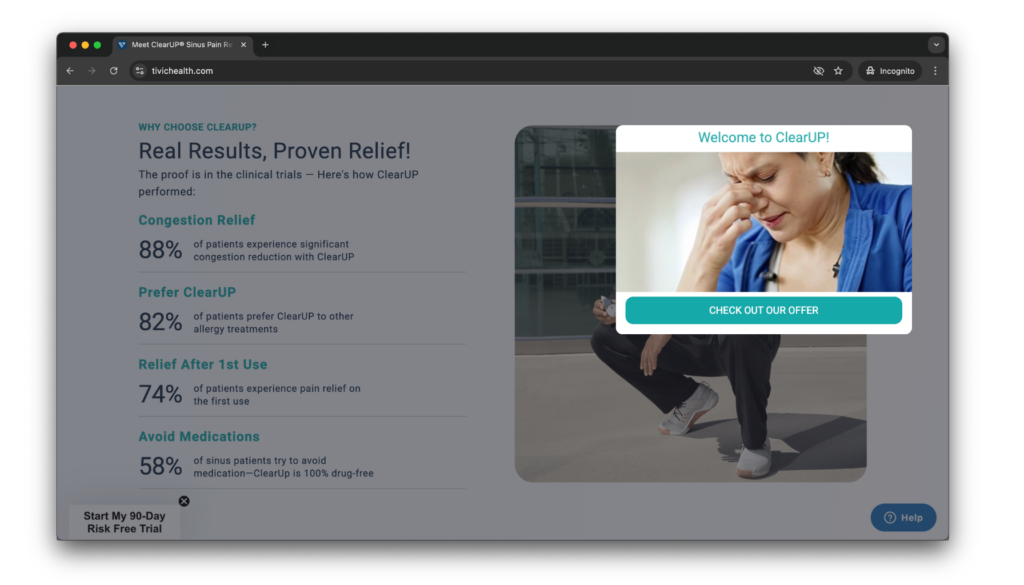
Everything was automated, running in real time to adapt the experience as visitors explored the site.
The results: After implementing Pathmonk, Tivic Health saw a +65% increase in purchases of ClearUP:
- 65% more website sales, driven by more relevant, timely content.
- 73% increase in cart additions, showing stronger intent to buy.
- 60% of visitors engaged with personalized micro-experiences, helping them feel more confident in their decision.
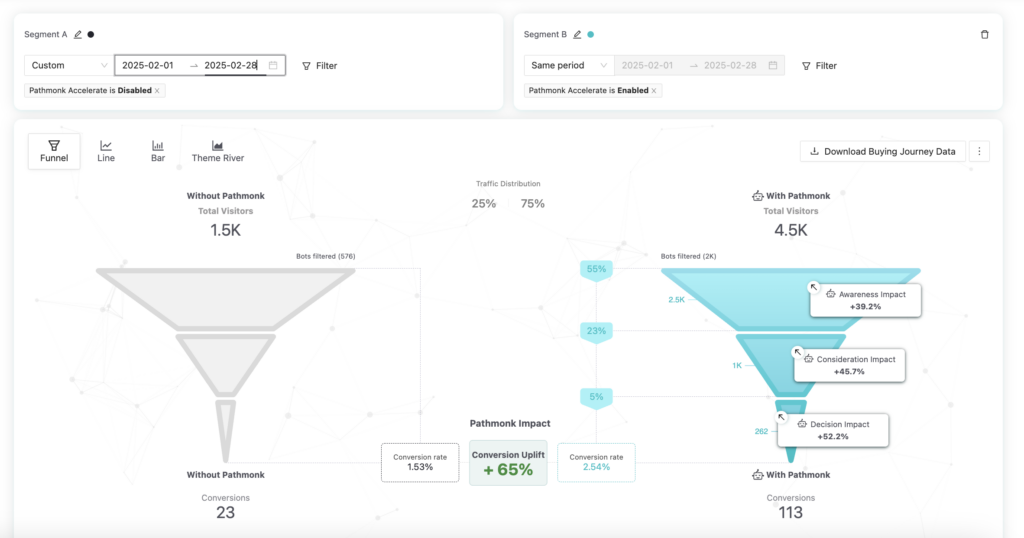
Everything was automated, running in real time to adapt the experience as visitors explored the site.
The results: After implementing Pathmonk, Tivic Health saw a +65% increase in purchases of ClearUP:
- 65% more website sales, driven by more relevant, timely content.
- 73% increase in cart additions, showing stronger intent to buy.
- 60% of visitors engaged with personalized micro-experiences, helping them feel more confident in their decision.
PRODUCT Set Up
How to get started with Pathmonk
FAQs Pathmonk & Healthcare industry
1. How can Pathmonk help healthcare companies improve website conversion rates?
Pathmonk empowers healthcare organizations to turn more website visitors into patients, clients, or partners by using AI-driven personalization. Instead of treating every visitor the same, Pathmonk analyzes real-time behavioral signals, like scroll depth, time on page, and navigation patterns, to understand what each person is interested in and how close they are to taking action.
This allows your website to respond dynamically, surfacing the right content or call to action precisely when it’s most relevant. For example, if someone has visited your appointment booking page multiple times without scheduling, Pathmonk can present a gentle reminder or an FAQ overlay that answers common concerns about booking.
What makes this approach especially powerful for healthcare is that it requires no complicated development work or massive redesigns. You simply define your primary goals—such as scheduling a consultation, downloading a treatment guide, or subscribing to a newsletter—and Pathmonk’s AI handles the rest.
This means you’re able to nurture trust and confidence while making it easier for patients or stakeholders to take the next step, all without adding friction to their experience. Over time, you’ll see more of your existing traffic converting, which ultimately reduces acquisition costs and supports stronger patient relationships.
2. Is Pathmonk compliant with healthcare privacy regulations?
Yes—Pathmonk was designed with privacy and compliance at the forefront. The platform operates with cookieless technology by default, meaning it doesn’t rely on tracking cookies to personalize website experiences.
For healthcare organizations, this is especially important because it reduces the complexity of complying with strict regulations like HIPAA in the United States or GDPR in Europe. Instead of processing or storing sensitive personal health information, Pathmonk focuses on anonymous behavioral signals, such as what pages were visited or how long someone stayed on the site. This approach allows you to optimize engagement while staying aligned with regulatory expectations around data protection.
Additionally, Pathmonk gives you full control over what data is collected and how it’s used. All tracking is transparent, and you can configure permissions to fit your organization’s compliance protocols. Whether you operate a hospital network, a telehealth platform, or a medical device company, you can feel confident that Pathmonk is built to safeguard user privacy without sacrificing the ability to improve your website’s performance.
If you have specific requirements or need to document compliance practices, the Pathmonk team can provide guidance and documentation to support your internal reviews.
3. What types of healthcare websites can benefit from Pathmonk?
Pathmonk is a versatile solution that supports nearly every kind of healthcare website, from local clinics and specialty practices to large hospital systems and healthcare SaaS providers. If your website has a core goal—such as acquiring new patients, scheduling appointments, enrolling users in a telemedicine platform, or educating professionals about your products—Pathmonk can help increase the percentage of visitors who take action. For example, a clinic’s website might use Pathmonk to guide prospective patients toward a booking form, while a healthcare software company could use it to encourage demo requests from procurement teams.
Beyond patient acquisition, Pathmonk is also effective for organizations focused on thought leadership and education. If you publish research, host webinars, or share compliance resources, the platform can highlight the most relevant materials to different audience segments.
This ensures that your visitors always see content that resonates with their needs, making it easier to build credibility and trust in an industry where clear communication is critical. Whether your site serves consumers, practitioners, or enterprise buyers, Pathmonk adapts to your unique objectives without requiring ongoing manual intervention.
4. How long does it take to implement Pathmonk on a healthcare website?
One of the biggest advantages of Pathmonk is how quick and straightforward it is to set up, even for healthcare organizations with complex websites. Typically, the implementation process takes just a few days from start to finish. You begin by adding a lightweight snippet to your website—this can be done manually or through tools like Google Tag Manager.
Once the script is installed, Pathmonk immediately starts collecting anonymous behavioral data to understand how visitors navigate your pages.
After setup, you’ll define your conversion goals, such as appointment bookings, form submissions, or resource downloads. From there, Pathmonk’s AI begins to analyze visitor intent and automatically personalize micro-experiences without requiring additional design or development work. Unlike traditional CRO tools that demand months of manual A/B testing, Pathmonk’s learning engine adapts in real time, so you can see meaningful improvements quickly.
The process is designed to be as hands-off as possible, freeing your team to focus on patient care and strategic marketing rather than technical configuration.
5. Will Pathmonk slow down my website?
Performance is a top concern for any healthcare website, especially since patients expect fast, seamless access to information and appointment tools. Pathmonk was built to be lightweight and non-intrusive. The script loads asynchronously, meaning it doesn’t block or delay the rest of your website content from appearing to visitors.
Even if your site already relies on other analytics or marketing tools, Pathmonk works harmoniously alongside them without causing conflicts or significant overhead.
Additionally, because Pathmonk’s experiences are delivered dynamically based on user behavior, the platform optimizes for speed and stability across all devices. This is particularly important for healthcare organizations whose audiences may include older patients or visitors in areas with slower internet connections.
By keeping load times fast and ensuring all interactions remain responsive, Pathmonk helps you maintain a high-quality user experience while driving better conversion results. You can also monitor performance directly through your analytics suite to confirm everything is running smoothly.
6. How does Pathmonk ensure messaging consistency with our brand?
Consistency is critical in healthcare, where trust and credibility can directly impact patient decisions. Pathmonk was designed to enhance your website’s messaging without disrupting your established brand guidelines. All the content and creative elements used in Pathmonk’s micro-experiences come directly from your own library of assets—whether that’s your headlines, images, trust badges, or calls to action. This means your tone of voice, design style, and compliance-approved messaging stay intact.
Rather than creating new messages out of thin air, Pathmonk focuses on timing and placement. It simply decides when to show each element to maximize relevance and impact. For example, if your brand emphasizes compassionate care, Pathmonk will surface patient testimonials or reassurance messages at moments when a visitor might hesitate to book an appointment.
You stay in control of what’s displayed, while the AI ensures your communications appear to the right audience at the right time. This combination of automation and brand stewardship helps you build confidence and engagement without sacrificing authenticity.
why companies choose pathmonk
How is Pathmonk different?
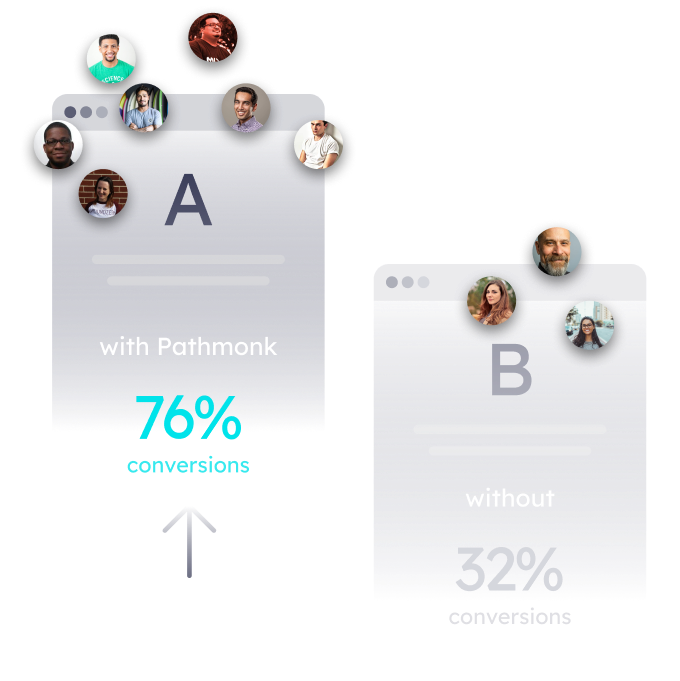
We guarantee results
Most tools promise improved conversions but rarely back it up with transparent data. We, on the other hand, provide a public conversion status dashboard, allowing clients to see real-time results from our platform.
On average, Pathmonk users experience a 50-60% boost in conversions, with a minimum increase of 25%. For high-performing websites, results typically range between 180-200%, and in some exceptional cases, clients have achieved conversion lifts as high as 600-700%.
We also offer a money-back guarantee if results fall below a 20% improvement. That said, we’ve never had to use it.
We're ridiculously easy to use
With Pathmonk, ease of use isn’t just a feature—it’s baked into the way we work.
What does this mean?
- It means implementation takes minutes, not weeks.
- It means onboarding is automated, guiding you step-by-step without needing external help.
- It means you don’t have to create extra content—Pathmonk uses your existing assets.
- It means there’s no manual setup—our AI takes care of it for you.
- It means personalization is fully automated, adapting in real time to each visitor’s intent.
- It means you focus on results, not configurations.
Other tools, like Mutiny, Unbounce, or Gong, rely heavily on manual setup or fixed targeting criteria, which means they can’t respond to changes in user behavior as they happen.
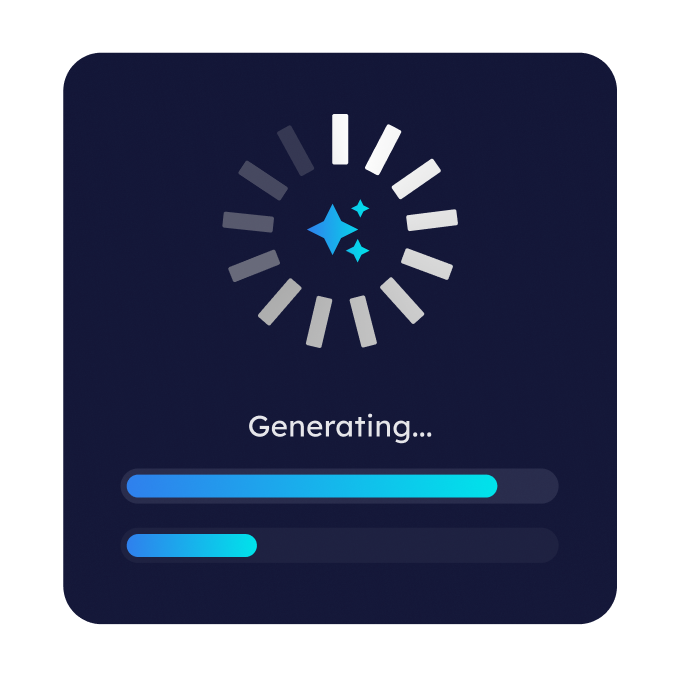
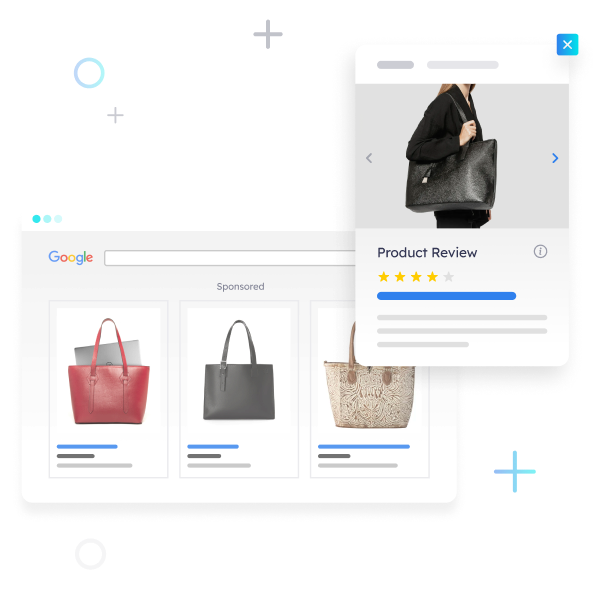
We’re accessible to all businesses
Unlike Dynamic Yield or Mutiny, enterprise-focused tools that require complex integrations and large budgets, Pathmonk is designed for businesses of all sizes. Our intuitive interface and automated setup mean you can start seeing results in hours—not weeks.
And with flexible, transparent pricing, you only pay for what you need, no matter the size of your website or marketing team.
results
This is what our customers experience on their website
Don’t just take our word for it. Find out how companies like yours are increasing their results effortlessly.

Best CRO Alternatives
Why Pathmonk is the smart choice
to boost your conversions
Fastest, easiest way to increase results
